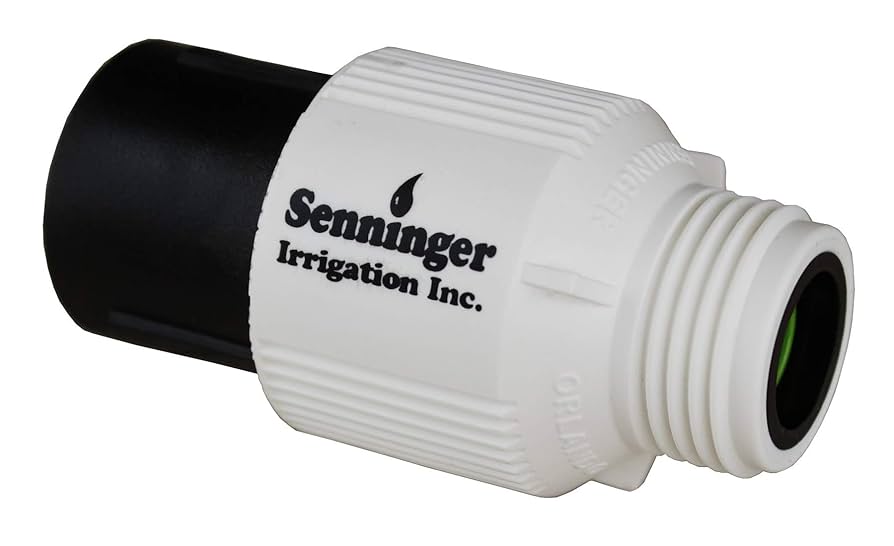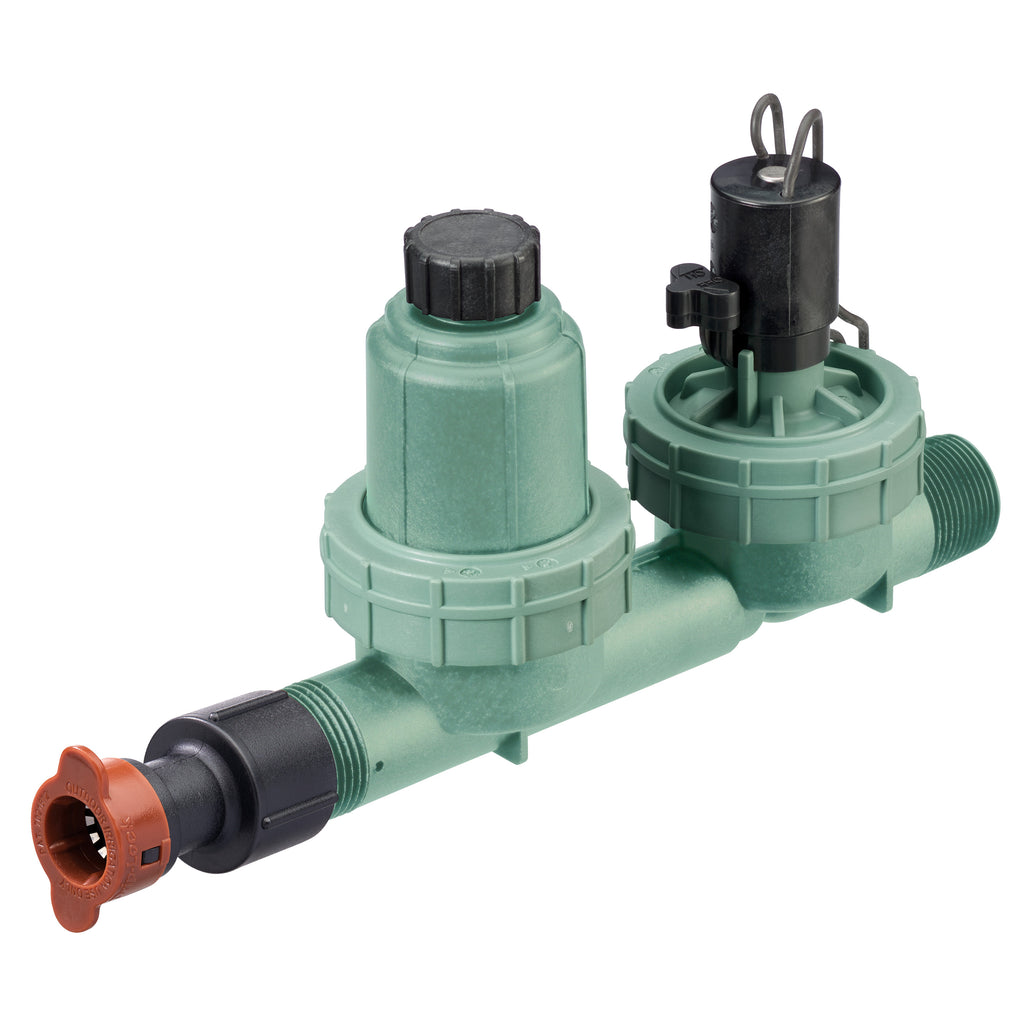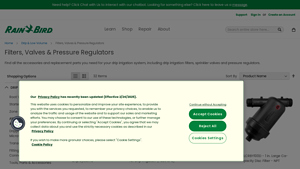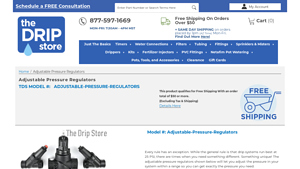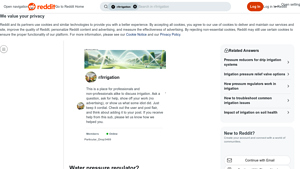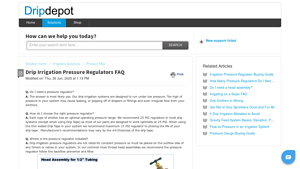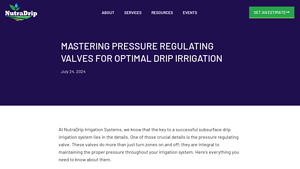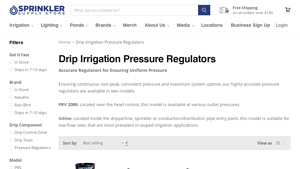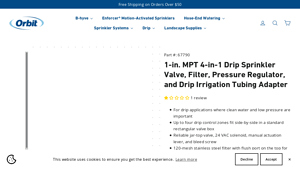Introduction: Navigating the Global Market for drip irrigation pressure regulator valve
Drip irrigation systems have become essential tools for maximizing water efficiency in agriculture, particularly in regions facing water scarcity. However, one of the key challenges in optimizing these systems is sourcing a reliable drip irrigation pressure regulator valve. These valves play a critical role in controlling water pressure, ensuring that plants receive the right amount of moisture without the risk of system damage. This guide is designed to provide international B2B buyers with a comprehensive overview of the various types of pressure regulators available, their applications, and the importance of selecting the right specifications for different agricultural needs.
In the pages that follow, we will delve into the different categories of pressure regulator valves, exploring their unique features and suitable applications across diverse environments—from the arid landscapes of Africa to the lush fields of South America, and beyond. Additionally, we will cover essential aspects such as supplier vetting processes, cost considerations, and maintenance tips, all tailored to empower you to make informed purchasing decisions. This resource aims to equip buyers from regions like Vietnam and Nigeria with the knowledge they need to navigate the complexities of sourcing high-quality drip irrigation pressure regulator valves, ensuring optimal performance and sustainability in their agricultural practices.
Understanding drip irrigation pressure regulator valve Types and Variations
| Type Name | Key Distinguishing Features | Primary B2B Applications | Brief Pros & Cons for Buyers |
|---|---|---|---|
| Fixed Pressure Regulators | Set to a specific pressure, simple design | Small-scale farms, home gardens | Pros: Easy to install; low maintenance. Cons: Limited flexibility in pressure adjustments. |
| Adjustable Pressure Regulators | Allow users to modify outlet pressure as needed | Commercial agriculture, greenhouse operations | Pros: Versatile; can accommodate varying system needs. Cons: More complex installation and potential for mechanical failure. |
| Inline Pressure Regulators | Installed directly within the irrigation line | Large-scale farms, industrial applications | Pros: Space-efficient; minimizes pressure loss. Cons: May require additional fittings for installation. |
| High-Flow Pressure Regulators | Designed for high-capacity systems, handles significant water flow | Orchards, vineyards, large landscapes | Pros: Supports extensive coverage; durable. Cons: Higher initial investment; may require specialized knowledge for setup. |
| Low-Flow Pressure Regulators | Tailored for systems with lower water flow requirements | Hydroponics, specialized crop production | Pros: Efficient water usage; ideal for delicate plants. Cons: Limited range of applications; may not suit larger operations. |
What Are the Characteristics of Fixed Pressure Regulators?
Fixed pressure regulators are designed to maintain a constant output pressure, making them ideal for small-scale farming and home gardening. Their simplicity allows for easy installation and low maintenance, which is appealing for B2B buyers with limited technical expertise. However, the lack of flexibility in pressure adjustments may be a drawback for those needing to adapt to varying water sources or crop requirements.
How Do Adjustable Pressure Regulators Cater to Diverse Needs?
Adjustable pressure regulators offer the flexibility to modify the outlet pressure, accommodating a range of irrigation systems. They are particularly suited for commercial agriculture and greenhouse operations, where varying crop types may demand different pressure settings. While these regulators provide versatility, their more complex installation process and potential for mechanical issues require buyers to consider their technical capabilities and ongoing maintenance needs.
Why Choose Inline Pressure Regulators for Large-Scale Operations?
Inline pressure regulators are installed directly within the irrigation line, making them an efficient choice for large-scale farms and industrial applications. Their design minimizes pressure loss and saves space, which is crucial for extensive irrigation systems. However, buyers should be aware that installation may require additional fittings, which can complicate the setup process.
What Advantages Do High-Flow Pressure Regulators Offer?
High-flow pressure regulators are engineered for systems that handle significant water flow, making them ideal for orchards, vineyards, and large landscapes. These regulators support extensive coverage and are built to withstand demanding conditions. The trade-off is a higher initial investment and the need for specialized knowledge during installation, which may deter some buyers.
In What Scenarios Are Low-Flow Pressure Regulators Most Effective?
Low-flow pressure regulators are specifically designed for irrigation systems with lower water flow requirements, such as hydroponics or specialized crop production. They promote efficient water usage, which is vital for sustainable practices, especially in regions facing water scarcity. However, their limited range of applications may not suit larger operations, making it essential for buyers to assess their specific irrigation needs before investing.
Key Industrial Applications of drip irrigation pressure regulator valve
| Industry/Sector | Specific Application of drip irrigation pressure regulator valve | Value/Benefit for the Business | Key Sourcing Considerations for this Application |
|---|---|---|---|
| Agriculture | Regulating water pressure in crop irrigation systems | Ensures optimal water delivery, reducing waste and enhancing crop yield | Compatibility with local water sources and emitter types |
| Horticulture | Maintaining consistent pressure for greenhouse watering | Promotes healthy plant growth by providing precise moisture levels | Durability to withstand greenhouse conditions |
| Landscaping | Controlling pressure in drip systems for residential projects | Enhances water efficiency and minimizes runoff, leading to cost savings | Adaptability to various garden layouts and soil types |
| Commercial Farming | Pressure regulation for large-scale irrigation systems | Increases operational efficiency and reduces labor costs | Scalability and ease of integration with existing systems |
| Municipal Water Management | Regulating pressure in public irrigation systems | Improves water distribution efficiency and reduces infrastructure strain | Compliance with local regulations and standards |
How is a Drip Irrigation Pressure Regulator Valve Used in Agriculture?
In agriculture, drip irrigation pressure regulator valves play a crucial role in managing water distribution for crops. By regulating high incoming water pressure to optimal levels, these valves prevent damage to irrigation systems and ensure that emitters function effectively. This is particularly vital in regions with fluctuating water pressures, such as parts of Africa and South America. Buyers should consider compatibility with local water sources and emitter types to maximize efficiency and crop yield.
What are the Benefits of Using Pressure Regulators in Horticulture?
In horticulture, pressure regulators are essential for maintaining consistent watering in greenhouses. They ensure that water is delivered at the right pressure, which is critical for the health of delicate plants. The ability to provide precise moisture levels can lead to improved plant growth and reduced water waste. For international buyers, durability against greenhouse conditions, such as high humidity and temperature variations, is a key consideration when sourcing these valves.
How Do Pressure Regulators Enhance Landscaping Projects?
For landscaping applications, drip irrigation pressure regulators control the pressure in systems designed for residential gardens. This functionality enhances water efficiency and minimizes runoff, which is especially important in areas prone to drought or water restrictions. By ensuring that water is delivered evenly across various garden layouts, businesses can achieve cost savings while promoting sustainable practices. Buyers should look for adaptability to different soil types and garden designs when sourcing these products.
Why are Pressure Regulators Important in Commercial Farming?
In commercial farming, pressure regulator valves are vital for large-scale irrigation systems. They help increase operational efficiency by ensuring that water is distributed uniformly across vast areas. This reduces labor costs associated with manual adjustments and allows for more effective water management, particularly in arid regions. Key sourcing considerations include the scalability of the regulators and their ease of integration with existing irrigation systems, which is critical for businesses looking to expand.
How Do Municipal Water Management Systems Benefit from Pressure Regulation?
Municipal water management systems utilize drip irrigation pressure regulators to maintain consistent pressure in public irrigation systems. This regulation improves water distribution efficiency and reduces strain on infrastructure, which is essential for sustainable urban development. For international B2B buyers, compliance with local regulations and standards is crucial when selecting pressure regulators, ensuring that the systems meet the necessary safety and operational requirements.
3 Common User Pain Points for ‘drip irrigation pressure regulator valve’ & Their Solutions
Scenario 1: Inconsistent Water Pressure Across Irrigation Zones
The Problem: One of the significant challenges faced by B2B buyers in the agricultural sector is the inconsistency of water pressure across different irrigation zones. This inconsistency can lead to uneven watering, resulting in some crops receiving too much water while others remain dry. Such variability not only affects crop health and yield but can also lead to increased operational costs due to inefficient water usage. Buyers often struggle to identify the right pressure regulator that can effectively manage varying pressure levels throughout their irrigation systems.
The Solution: To tackle this issue, it is crucial to select adjustable pressure regulator valves that can accommodate different flow rates and pressures. When sourcing these regulators, buyers should look for models with a range of preset pressure options, allowing for customization based on the specific needs of each irrigation zone. Additionally, implementing a zoned irrigation design can help manage pressure more effectively. This involves using multiple regulators that are strategically placed throughout the system, ensuring each zone receives the appropriate pressure. Regular maintenance checks should also be scheduled to ensure that regulators are functioning correctly and are free from debris that could affect their performance.
Scenario 2: Frequent System Failures Due to High Pressure
The Problem: Many agricultural businesses experience frequent failures in their drip irrigation systems due to excessively high incoming water pressure. This not only leads to damage to the drip lines and emitters but also results in costly repairs and system downtimes. B2B buyers often find themselves in a situation where they must replace damaged components repeatedly, which can disrupt operations and lead to financial losses.
The Solution: To mitigate the risk of system failures, it is essential to install pressure regulators that can withstand higher incoming pressures while maintaining a consistent output. Buyers should assess the water pressure at their source and choose regulators rated for that pressure, with a safety margin. It’s advisable to select robust models made of durable materials, such as high-strength ABS plastic, which can better resist wear and tear. Furthermore, incorporating pressure relief valves can provide an additional layer of protection by automatically venting excess pressure, thus preventing damage to the irrigation system. Regular training for staff on monitoring pressure levels can also empower them to take proactive measures before issues escalate.
Scenario 3: Difficulty in Selecting the Right Pressure Regulator
The Problem: B2B buyers often face confusion when trying to select the appropriate pressure regulator for their specific drip irrigation systems. With various types and specifications available, it can be overwhelming to determine which model will best fit their operational requirements. This indecision can lead to purchasing unsuitable equipment, resulting in inefficiencies and wasted resources.
The Solution: To simplify the selection process, buyers should begin by conducting a thorough assessment of their irrigation needs, including flow rates, pressure requirements, and the specific types of crops being irrigated. Utilizing a pressure regulator sizing chart can provide valuable insights into which models will work best based on these parameters. Additionally, consulting with irrigation specialists or manufacturers can provide tailored recommendations and highlight the most suitable products for their unique situations. Establishing a relationship with suppliers who offer a range of products can also facilitate easier access to replacement parts or upgrades in the future. Finally, buyers should consider investing in user-friendly adjustable pressure regulators, which allow for easy modifications in response to changing agricultural conditions.
Strategic Material Selection Guide for drip irrigation pressure regulator valve
What Are the Key Materials for Drip Irrigation Pressure Regulator Valves?
When selecting materials for drip irrigation pressure regulator valves, it’s crucial to consider properties that affect performance, durability, and cost. Here, we analyze four common materials used in the construction of these valves: PVC, brass, stainless steel, and high-density polyethylene (HDPE).
How Does PVC Perform in Drip Irrigation Applications?
Key Properties: PVC (Polyvinyl Chloride) is lightweight and offers excellent chemical resistance, making it suitable for various water sources. It typically operates effectively at temperatures up to 60°C (140°F) and can withstand moderate pressure levels.
Pros & Cons: PVC is cost-effective and easy to manufacture, which translates to lower production costs. However, it can become brittle over time, especially under UV exposure, which limits its lifespan in outdoor applications.
Impact on Application: PVC is compatible with most irrigation media, but it may not be suitable for high-pressure systems or extreme temperatures.
Considerations for International Buyers: PVC products must comply with local standards, such as ASTM in the U.S. or DIN in Europe. Buyers should verify the quality and certification of PVC materials, especially in regions with strict regulations.
What Are the Benefits of Brass in Pressure Regulators?
Key Properties: Brass is a durable metal that can handle high pressures and temperatures, typically rated up to 120°C (248°F). It also exhibits excellent corrosion resistance, especially in water applications.
Pros & Cons: The main advantage of brass is its strength and longevity, making it ideal for high-performance applications. However, brass is more expensive than plastic alternatives, and its manufacturing process can be complex.
Impact on Application: Brass is highly compatible with various media, including potable water, and is less likely to degrade over time compared to plastic options.
Considerations for International Buyers: Brass components should meet international standards, such as JIS in Japan or BS in the UK. Buyers should also consider the availability of brass in their local markets, as it may be subject to import tariffs.
Why Choose Stainless Steel for Drip Irrigation Pressure Regulators?
Key Properties: Stainless steel offers exceptional strength and corrosion resistance, withstanding temperatures up to 200°C (392°F). It is also resistant to rust and scaling, making it suitable for diverse environments.
Pros & Cons: The durability of stainless steel makes it ideal for long-term applications. However, it is the most expensive option among the materials discussed and may require specialized manufacturing techniques.
Impact on Application: Its compatibility with various fluids, including aggressive chemicals, makes stainless steel a versatile choice for diverse agricultural settings.
Considerations for International Buyers: Buyers should ensure that stainless steel products comply with relevant standards, such as ASTM A312 for pipes. Additionally, the availability of specific grades (like 304 or 316) may vary by region.
What Role Does High-Density Polyethylene (HDPE) Play?
Key Properties: HDPE is known for its high strength-to-density ratio and can handle temperatures up to 80°C (176°F). It is also resistant to many chemicals, making it suitable for various irrigation applications.
Pros & Cons: HDPE is lightweight and flexible, which simplifies installation. However, it may not withstand high-pressure applications as effectively as metals.
Impact on Application: HDPE is compatible with a wide range of irrigation media, but its performance can be limited in extreme conditions.
Considerations for International Buyers: HDPE products should comply with local standards, such as ISO certifications. Buyers should also consider the environmental impact of HDPE and its recyclability in their regions.
Summary Table of Material Selection for Drip Irrigation Pressure Regulator Valves
| Material | Typical Use Case for drip irrigation pressure regulator valve | Key Advantage | Key Disadvantage/Limitation | Relative Cost (Low/Med/High) |
|---|---|---|---|---|
| PVC | Low-pressure systems, residential irrigation | Cost-effective and lightweight | Brittle under UV exposure | Low |
| Brass | High-performance, commercial applications | Durable and corrosion-resistant | Higher cost and complex manufacturing | High |
| Stainless Steel | Aggressive chemical environments | Exceptional strength and longevity | Most expensive option | High |
| HDPE | Flexible and lightweight installations | Easy to install and resistant to many chemicals | Limited high-pressure capability | Medium |
This material selection guide provides B2B buyers with essential insights into the various materials available for drip irrigation pressure regulator valves, enabling informed purchasing decisions tailored to their specific regional and operational needs.
In-depth Look: Manufacturing Processes and Quality Assurance for drip irrigation pressure regulator valve
What Are the Main Stages of Manufacturing Drip Irrigation Pressure Regulator Valves?
The manufacturing process of drip irrigation pressure regulator valves encompasses several critical stages that ensure the final product meets performance and durability standards. These stages include material preparation, forming, assembly, and finishing.
Material Preparation
The manufacturing process begins with selecting high-quality raw materials, typically high-strength ABS plastic or brass, which are essential for the valve’s longevity and resistance to environmental factors. The materials undergo rigorous inspection to ensure they meet specified standards.
Forming Techniques
Once the materials are confirmed, they are subjected to various forming techniques. Injection molding is commonly used for plastic components, allowing for precise shaping and minimal waste. For metal components, processes such as CNC machining or die-casting are employed to achieve the required specifications.
Assembly Process
Following the forming stage, components are assembled. This stage often utilizes automated machinery for efficiency, but skilled labor is also crucial for quality assurance. The assembly process includes integrating the diaphragm, seals, and any electronic components if applicable.
Finishing Touches
The final stage of manufacturing involves surface treatments and quality checks. This may include polishing, coating, or painting to enhance durability and aesthetic appeal. After finishing, valves are prepared for packaging and shipment.
How Is Quality Control Implemented in the Manufacturing of Pressure Regulators?
Quality control (QC) is integral to the manufacturing of drip irrigation pressure regulator valves, ensuring that every product meets international standards and customer specifications. The QC process typically follows several key checkpoints, including Incoming Quality Control (IQC), In-Process Quality Control (IPQC), and Final Quality Control (FQC).
International Standards for Quality Assurance
Manufacturers often adhere to international quality management standards such as ISO 9001, which outlines requirements for an effective quality management system. Compliance with industry-specific standards, such as CE marking in Europe or API certification for certain valves, is also crucial for assuring product quality and safety.
QC Checkpoints Explained
1. Incoming Quality Control (IQC): This initial checkpoint involves inspecting raw materials and components as they arrive at the facility. Any materials that do not meet the specified standards are rejected to prevent defects in the final product.
In-Process Quality Control (IPQC): During manufacturing, various processes are monitored to ensure adherence to quality standards. This includes regular checks of dimensions, tolerances, and performance specifications throughout the forming and assembly stages.
Final Quality Control (FQC): Once the valves are assembled, FQC takes place. This involves comprehensive testing of each valve to assess functionality, pressure regulation, and durability under simulated conditions. Common tests include pressure tests, flow rate tests, and durability assessments.
What Testing Methods Are Commonly Used for Pressure Regulator Valves?
To ensure that drip irrigation pressure regulator valves perform effectively, manufacturers employ a variety of testing methods. These methods are crucial for verifying the performance and reliability of the valves under different conditions.
Common Testing Methods
– Pressure Testing: This test evaluates the valve’s ability to maintain a set pressure under varying conditions. The valve is subjected to pressures above its operational limits to ensure it can handle unexpected surges without failure.
Flow Rate Testing: This method measures how well the valve regulates flow at different pressures. Consistency in flow rates is essential for maintaining the efficiency of drip irrigation systems.
Durability Testing: Valves are exposed to extreme environmental conditions, such as temperature fluctuations and exposure to corrosive substances, to assess their long-term performance.
How Can B2B Buyers Verify Supplier Quality Control?
For international B2B buyers, particularly those from regions like Africa, South America, the Middle East, and Europe, verifying supplier quality control is vital for ensuring product reliability and compliance with local regulations.
Conducting Supplier Audits
One effective method is conducting supplier audits. These audits allow buyers to evaluate the manufacturing processes, quality management systems, and compliance with international standards firsthand.
Requesting Quality Control Reports
Buyers should also request detailed QC reports from suppliers. These reports should outline testing results, compliance with standards, and any certifications that the manufacturer holds. This transparency helps in assessing the reliability of the products.
Engaging Third-Party Inspection Services
Utilizing third-party inspection services can further enhance confidence in product quality. These services provide independent assessments of manufacturing processes and product performance, ensuring that suppliers meet the specified quality standards.
What Are the Quality Control and Certification Nuances for International Buyers?
Navigating quality control and certification can be particularly nuanced for international buyers due to varying standards across regions.
Understanding Regional Standards
For instance, European buyers may prioritize CE certification, while buyers in the Middle East may focus on local standards like the Gulf Cooperation Council (GCC) certification. Understanding these regional requirements is essential for ensuring compliance and product acceptance.
Considering Local Regulations
In addition to international standards, local regulations can affect the certification process. Buyers should be aware of any specific requirements in their region, such as environmental regulations or safety standards, that could impact the product’s usability.
Building Relationships with Reliable Suppliers
Establishing long-term relationships with reputable suppliers who have a proven track record of quality control can mitigate risks associated with non-compliance. Regular communication and feedback can help maintain quality standards over time.
In conclusion, understanding the manufacturing processes and quality assurance protocols for drip irrigation pressure regulator valves is essential for B2B buyers. By focusing on manufacturing stages, quality control checkpoints, testing methods, and the nuances of certification, buyers can make informed decisions that enhance the efficiency and reliability of their irrigation systems.
Practical Sourcing Guide: A Step-by-Step Checklist for ‘drip irrigation pressure regulator valve’
In the competitive landscape of agricultural technology, sourcing the right drip irrigation pressure regulator valve is crucial for optimizing irrigation efficiency and ensuring system longevity. This guide provides a structured checklist to assist international B2B buyers in making informed procurement decisions.
Step 1: Define Your Technical Specifications
Begin by establishing the technical requirements for your drip irrigation system. Consider factors such as the desired outlet pressure, flow rate, and compatibility with existing infrastructure. Specific details include:
– Pressure Range: Identify the necessary pressure range (e.g., 10-30 PSI) that will ensure optimal emitter performance.
– Flow Rate Compatibility: Ensure the regulator’s flow rate aligns with your system’s needs, whether low, medium, or high flow.
Step 2: Research and Identify Reputable Suppliers
Conduct thorough research to find reliable suppliers with a strong reputation in the industry. Look for companies that specialize in irrigation solutions and have a proven track record. Key aspects to evaluate include:
– Industry Experience: Assess how long the supplier has been in the market and their experience with similar products.
– Customer Reviews: Seek out testimonials and case studies from other buyers, especially in your target regions like Africa, South America, and Europe.
Step 3: Evaluate Product Quality and Specifications
Request detailed product specifications and quality certifications for the pressure regulator valves you are considering. High-quality materials and construction are vital for durability and performance. Focus on:
– Material Composition: Look for valves made from high-strength ABS plastic or other durable materials that can withstand environmental stresses.
– Quality Certifications: Ensure the products meet international standards and certifications, such as ISO or CE, which can be crucial for operational reliability.
Step 4: Request Samples or Demonstrations
Before finalizing a purchase, it’s wise to request samples or demonstrations of the pressure regulators. This allows you to assess their functionality and compatibility with your systems. Consider:
– Testing Performance: Evaluate how the regulators perform under different pressure conditions to ensure they meet your operational standards.
– Installation Ease: Check the design for user-friendliness and compatibility with your existing irrigation infrastructure.
Step 5: Verify Supplier Certifications
Ensure that your selected suppliers hold relevant certifications and comply with industry regulations. This step mitigates risks associated with product quality and supplier reliability. Key points include:
– Manufacturer Certifications: Look for certifications that confirm the manufacturing process adheres to quality and safety standards.
– Warranty and Support: Check if the supplier offers warranties and after-sales support, which can be crucial for troubleshooting and maintenance.
Step 6: Compare Pricing and Terms
After narrowing down your options, compare pricing structures and payment terms from different suppliers. While cost is important, consider the overall value, which includes product quality and service. Important considerations include:
– Bulk Pricing Options: Inquire about discounts for bulk purchases, which can lead to significant cost savings.
– Payment Terms: Understand the payment conditions, including deposits, credit terms, and any potential hidden fees.
Step 7: Finalize Your Order and Establish Communication
Once you have selected a supplier, finalize your order while ensuring clear communication about expectations and delivery timelines. Confirm:
– Order Confirmation: Ensure you receive an order confirmation that outlines all agreed-upon terms.
– Communication Channels: Establish reliable communication channels for updates on order status and any potential issues that may arise during delivery.
By following these steps, B2B buyers can confidently source drip irrigation pressure regulator valves that meet their operational needs, ensuring efficient and effective irrigation practices.
Comprehensive Cost and Pricing Analysis for drip irrigation pressure regulator valve Sourcing
What Are the Key Cost Components in Sourcing Drip Irrigation Pressure Regulator Valves?
When sourcing drip irrigation pressure regulator valves, understanding the cost structure is vital for effective budgeting and procurement. The primary cost components include:
Materials: The choice of materials significantly influences the price. Common materials such as high-strength ABS plastic and brass for fittings have varying costs. High-quality materials may initially appear more expensive but can lead to long-term savings through durability and reduced maintenance needs.
Labor: Labor costs vary by region and can be affected by local wage standards. Skilled labor may be necessary for assembly and quality checks, impacting overall pricing.
Manufacturing Overhead: This includes costs related to facilities, utilities, and administrative expenses. Efficient production processes can help reduce overhead, but suppliers with higher overhead costs may pass these expenses onto buyers.
Tooling: If custom designs are required, tooling costs can be substantial. These costs should be factored into the total price, especially for low-volume orders.
Quality Control (QC): Rigorous quality control processes ensure that products meet industry standards. While this may increase upfront costs, it reduces the risk of failure, which can be more costly in the long run.
Logistics: Shipping costs can vary dramatically based on location, weight, and transport method. For international buyers, understanding Incoterms is crucial to determine who bears these costs.
Margin: Suppliers typically include a profit margin in their pricing. This margin can vary based on competition, market demand, and supplier reputation.
How Do Price Influencers Affect the Cost of Drip Irrigation Pressure Regulators?
Several factors can influence the pricing of drip irrigation pressure regulator valves:
Volume/MOQ: Purchasing in larger quantities often results in lower per-unit costs. Understanding the minimum order quantities (MOQ) can help buyers negotiate better deals.
Specifications and Customization: Custom specifications may lead to increased costs due to additional design and tooling requirements. Buyers should assess whether customization is necessary or if standard products suffice.
Materials: The selection of materials directly impacts pricing. Opting for premium materials can enhance product longevity but will increase initial costs.
Quality and Certifications: Products that meet international standards or carry certifications (e.g., ISO, CE) may command higher prices. However, these certifications can also enhance product reliability and acceptance in international markets.
Supplier Factors: The supplier’s reputation, production capabilities, and location can all affect pricing. Established suppliers may offer better service and quality assurance but at a premium.
Incoterms: Understanding shipping terms like FOB (Free On Board) or CIF (Cost, Insurance, and Freight) is essential for international transactions. These terms dictate who is responsible for shipping costs and risks, impacting the total cost.
What Are the Best Buyer Tips for Cost-Efficiency in Drip Irrigation Pressure Regulator Sourcing?
To optimize sourcing strategies, international B2B buyers should consider the following tips:
Negotiate Effectively: Building a strong relationship with suppliers can lead to better pricing and terms. Don’t hesitate to negotiate on price, payment terms, and delivery schedules.
Evaluate Total Cost of Ownership (TCO): Consider not just the purchase price but also maintenance, replacement, and operational costs over the product’s lifecycle. A higher upfront cost may be justified if the product delivers savings in the long run.
Understand Pricing Nuances for International Markets: Buyers from regions like Africa, South America, the Middle East, and Europe should be aware of local market conditions that may affect pricing. Currency fluctuations, import tariffs, and local demand can all influence costs.
Seek Multiple Quotes: Obtaining quotes from various suppliers provides leverage in negotiations and helps identify competitive pricing.
Consider Local Suppliers: Whenever possible, sourcing from local suppliers can reduce logistics costs and lead times. Local suppliers may also have a better understanding of regional needs and regulations.
In conclusion, a comprehensive understanding of the cost structure and pricing influencers for drip irrigation pressure regulator valves can empower B2B buyers to make informed sourcing decisions. This knowledge not only aids in negotiating favorable terms but also enhances overall procurement efficiency.
Alternatives Analysis: Comparing drip irrigation pressure regulator valve With Other Solutions
When considering drip irrigation systems, selecting the right pressure management solution is crucial for optimizing water usage and ensuring system longevity. While drip irrigation pressure regulator valves are widely utilized, several alternative technologies and methods exist that can also meet similar objectives. Below is a comparison of drip irrigation pressure regulator valves with two viable alternatives: adjustable pressure regulators and flow control valves.
| Comparison Aspect | Drip Irrigation Pressure Regulator Valve | Adjustable Pressure Regulators | Flow Control Valves |
|---|---|---|---|
| Performance | Maintains consistent pressure, preventing damage to emitters | Offers flexibility in pressure settings, ideal for varying conditions | Controls flow rate but may not regulate pressure consistently |
| Cost | Moderate initial investment, with low long-term costs | Generally higher upfront costs due to advanced features | Lower cost, but potential for higher maintenance expenses |
| Ease of Implementation | Simple installation, often requires no specialized tools | May require calibration and additional setup | Straightforward installation, but may need adjustments for optimal flow |
| Maintenance | Low maintenance; occasional checks needed | Requires periodic calibration and checks | Regular maintenance needed to prevent clogging and ensure functionality |
| Best Use Case | Ideal for consistent pressure environments; small to medium agricultural applications | Best for varied terrain or changing conditions; adaptable for diverse crops | Suitable for large-scale operations where flow variability is expected |
What Are the Pros and Cons of Adjustable Pressure Regulators?
Adjustable pressure regulators offer a high degree of flexibility by allowing users to set the desired outlet pressure according to specific system requirements. This adaptability makes them particularly useful in environments where water pressure fluctuates significantly or where different crops have varying pressure needs. However, their complexity can lead to higher initial costs and the necessity for regular calibration, which might not be feasible for all operations, especially smaller ones.
How Do Flow Control Valves Compare in Terms of Performance?
Flow control valves are another option that can help manage water flow within a drip irrigation system. They function by adjusting the amount of water passing through, which can be beneficial in scenarios where water conservation is essential. While generally more affordable than pressure regulators, flow control valves may not provide the same level of pressure regulation, potentially leading to uneven water distribution. This inconsistency can affect crop health and yield, making them less ideal for sensitive applications.
Conclusion: Which Solution Is Right for Your Business Needs?
In choosing the right solution for your drip irrigation needs, B2B buyers should consider the specific requirements of their agricultural operations. If consistent pressure is paramount for optimal emitter performance, a drip irrigation pressure regulator valve is likely the best choice. For operations that require adaptability to varying water pressures and crop types, adjustable pressure regulators can provide the necessary flexibility. Conversely, if budget constraints are significant and the operation can tolerate some variability in water distribution, flow control valves may serve as a cost-effective solution. Ultimately, evaluating the unique conditions and long-term goals of your irrigation system will guide you in selecting the most suitable approach.
Essential Technical Properties and Trade Terminology for drip irrigation pressure regulator valve
What Are the Essential Technical Properties of Drip Irrigation Pressure Regulator Valves?
Understanding the technical properties of drip irrigation pressure regulator valves is crucial for B2B buyers looking to optimize irrigation systems. Here are some key specifications that impact performance and durability:
Material Grade
The material used in pressure regulators, such as high-strength ABS plastic or brass, is vital for ensuring longevity and resistance to environmental conditions. ABS plastic is lightweight and resistant to corrosion, making it suitable for various climates. Brass, on the other hand, offers durability and strength, particularly in high-pressure applications. Selecting the right material can significantly influence the regulator’s lifespan and maintenance needs.Pressure Rating
This specification indicates the maximum pressure the regulator can handle, typically measured in PSI (pounds per square inch). Regulators with a pressure rating of 30 PSI or higher are common in commercial applications. Understanding the pressure requirements of your irrigation system is essential to avoid damage to emitters and fittings, ensuring optimal water distribution.Flow Rate Capacity
Measured in gallons per minute (GPM), the flow rate capacity indicates how much water can pass through the regulator without compromising performance. Regulators are available in low-flow, medium-flow, and high-flow options, which are critical for matching the regulator to the specific needs of your irrigation system. Choosing the correct flow rate ensures efficient water delivery and reduces waste.Adjustability
Adjustable pressure regulators allow users to set the desired outlet pressure based on specific irrigation needs. This feature is particularly beneficial for systems that may experience varying pressure levels due to environmental factors. The ability to adjust pressure can optimize water usage and enhance crop yield, making it a valuable feature for agricultural operations.Tolerance Levels
Tolerance refers to the acceptable range of deviation from the specified pressure setting. A regulator with a tight tolerance ensures consistent pressure delivery, which is crucial for maintaining the efficiency of the irrigation system. High tolerance levels contribute to the reliability of the system, reducing the risk of over or under-irrigation.
What Trade Terminology Should B2B Buyers Know When Purchasing Drip Irrigation Pressure Regulators?
Familiarity with industry-specific terminology can streamline communication and enhance purchasing decisions for B2B buyers. Here are some common terms:
OEM (Original Equipment Manufacturer)
This term refers to companies that produce parts or equipment that may be marketed by another manufacturer. Understanding OEM relationships can help buyers identify reputable sources for replacement parts and ensure compatibility with existing systems.MOQ (Minimum Order Quantity)
MOQ is the smallest quantity of a product that a supplier is willing to sell. Knowing the MOQ is essential for budgeting and inventory planning, particularly for larger agricultural operations where bulk purchases may be necessary.RFQ (Request for Quotation)
An RFQ is a formal document issued by buyers to suppliers requesting pricing information for specific products. This process is crucial for obtaining competitive pricing and understanding the cost structure of different suppliers.Incoterms (International Commercial Terms)
These are standardized trade terms used in international contracts to clarify the responsibilities of buyers and sellers regarding shipping, delivery, and insurance. Familiarity with Incoterms helps buyers understand their obligations and risks in the shipping process.Back Pressure
This term refers to the pressure that opposes the flow of water in the irrigation system. Understanding back pressure is important for selecting the right regulator, as it affects how well the system can maintain consistent pressure and flow rates.Flow Regulation
Flow regulation describes the process of controlling the amount of water that flows through the irrigation system. Proper flow regulation is essential for ensuring that plants receive the right amount of water, ultimately affecting crop health and yield.
By grasping these technical properties and trade terms, B2B buyers can make informed decisions when selecting drip irrigation pressure regulator valves, optimizing their irrigation systems for efficiency and productivity.
Navigating Market Dynamics and Sourcing Trends in the drip irrigation pressure regulator valve Sector
What Are the Current Market Dynamics and Key Trends Affecting the Drip Irrigation Pressure Regulator Valve Sector?
The global drip irrigation pressure regulator valve market is experiencing significant growth, driven by the increasing need for efficient water management in agriculture, particularly in water-scarce regions like Africa, South America, and the Middle East. As climate change intensifies the demand for sustainable farming practices, these regions are turning to drip irrigation systems to optimize water use. Technological advancements, such as smart irrigation systems and IoT-enabled pressure regulators, are also emerging trends that enhance system efficiency and user control. This shift towards digitalization is particularly appealing to international B2B buyers looking for reliable solutions that reduce operational costs while maximizing yield.
Moreover, the market is witnessing a diversification of products to cater to various agricultural needs. Buyers can now choose from low-flow, medium-flow, and high-flow pressure regulators tailored to specific crop requirements. With the advent of e-commerce platforms, sourcing these products has become more accessible, enabling buyers to compare prices and specifications from multiple suppliers across continents. This ease of access is crucial for businesses in developing regions, where efficient procurement processes can significantly impact agricultural productivity.
How Does Sustainability and Ethical Sourcing Influence the Drip Irrigation Pressure Regulator Valve Market?
Sustainability is becoming a cornerstone of the drip irrigation industry, especially as environmental concerns gain traction globally. The production of pressure regulator valves now increasingly focuses on using recyclable materials and energy-efficient manufacturing processes. B2B buyers are recognizing the importance of partnering with suppliers who prioritize sustainable practices, not only to meet regulatory requirements but also to enhance their own brand reputation.
Furthermore, ethical sourcing is paramount for companies operating in regions like Africa and South America, where social responsibility can impact community relations and market acceptance. Many suppliers are obtaining ‘green’ certifications that validate their commitment to environmental stewardship and ethical labor practices. Buyers are encouraged to inquire about the certifications held by manufacturers, as these can serve as indicators of product quality and sustainability. By opting for ethically sourced materials, businesses can contribute to a more sustainable supply chain while also ensuring compliance with increasingly stringent environmental regulations.
What Is the Historical Context of the Drip Irrigation Pressure Regulator Valve Industry?
The evolution of drip irrigation systems dates back to the 1960s when Israeli farmers pioneered the technology to maximize water efficiency in arid conditions. As agricultural practices evolved, the need for pressure regulation became evident, leading to the development of specialized valves designed to maintain optimal pressure levels for drip systems. Over the decades, innovations in materials and design have transformed pressure regulators into more reliable and efficient components of irrigation systems. Today, these valves not only serve their primary function of pressure regulation but also incorporate advanced features that contribute to the overall efficiency and sustainability of agricultural practices worldwide.
By understanding the historical context and current trends in the drip irrigation pressure regulator valve market, B2B buyers can make informed decisions that align with their operational goals and sustainability commitments.
Frequently Asked Questions (FAQs) for B2B Buyers of drip irrigation pressure regulator valve
How do I solve excessive water pressure issues in my drip irrigation system?
To manage excessive water pressure in a drip irrigation system, installing a pressure regulator valve is essential. These devices reduce incoming water pressure to a manageable level that is suitable for drip emitters, thus preventing damage. Select a regulator that matches your system’s flow rate and pressure requirements. Regular maintenance checks should also be conducted to ensure the regulator operates effectively, as clogs or wear can lead to pressure inconsistencies.What is the best pressure regulator valve for drip irrigation systems?
The best pressure regulator valve for your drip irrigation system depends on your specific needs, such as the type of crops, soil conditions, and water pressure. Generally, options range from low-flow to high-flow regulators. For systems with fluctuating pressure, adjustable pressure regulators can offer flexibility. It’s advisable to consult with suppliers to identify a model that meets your system’s specifications and environmental conditions.What are the key factors to consider when sourcing drip irrigation pressure regulators internationally?
When sourcing drip irrigation pressure regulators, consider the supplier’s reliability, product quality, and compliance with international standards. Assess their capacity for customization and the range of products offered. Additionally, inquire about their experience in your specific market region, as local environmental conditions can affect product suitability. Request samples and certifications to evaluate quality before making bulk purchases.How can I vet suppliers for drip irrigation pressure regulators?
To vet suppliers, start by checking their industry reputation through reviews and testimonials. Verify their certifications and compliance with international quality standards. Engage in direct communication to assess their responsiveness and willingness to provide detailed product information. Additionally, request references from previous clients, especially those in your region, to understand their experience with the supplier.What are typical minimum order quantities (MOQ) for pressure regulator valves?
Minimum order quantities for pressure regulator valves can vary widely based on the manufacturer and product type. Generally, MOQs can range from a few dozen to several hundred units. It’s essential to discuss your needs with suppliers to see if they can accommodate smaller orders, especially for new buyers or trials. Some suppliers may offer flexible terms for established partnerships.What payment terms should I expect when purchasing internationally?
Payment terms for international purchases of drip irrigation pressure regulators typically include options like advance payment, letters of credit, or payment upon delivery. Discussing terms upfront with suppliers is crucial to ensure clarity. Consider using secure payment methods that offer buyer protection. Also, be aware of any currency exchange risks and additional fees associated with international transactions.How do I ensure quality assurance (QA) for my drip irrigation components?
To ensure quality assurance, request product samples before placing large orders. Establish clear quality standards with your supplier, including specifications for materials, testing procedures, and compliance with international standards. Implement a quality control process upon receiving products, including inspections and testing for functionality. Consider third-party inspection services for larger shipments to guarantee that products meet your requirements.What logistics considerations should I keep in mind for importing pressure regulator valves?
When importing pressure regulator valves, consider shipping methods, lead times, and customs regulations specific to your country. Work with logistics providers experienced in agricultural equipment to ensure timely and safe delivery. Understand the import duties and taxes that may apply, and factor these costs into your budget. Additionally, ensure that your supplier can provide necessary documentation for customs clearance to avoid delays.
Important Disclaimer & Terms of Use
⚠️ Important Disclaimer
The information provided in this guide, including content regarding manufacturers, technical specifications, and market analysis, is for informational and educational purposes only. It does not constitute professional procurement advice, financial advice, or legal advice.
While we have made every effort to ensure the accuracy and timeliness of the information, we are not responsible for any errors, omissions, or outdated information. Market conditions, company details, and technical standards are subject to change.
B2B buyers must conduct their own independent and thorough due diligence before making any purchasing decisions. This includes contacting suppliers directly, verifying certifications, requesting samples, and seeking professional consultation. The risk of relying on any information in this guide is borne solely by the reader.
Top 7 Drip Irrigation Pressure Regulator Valve Manufacturers & Suppliers List
1. Rainbird – Drip Irrigation Accessories
Domain: store.rainbird.com
Registered: 1995 (30 years)
Introduction: This company, Rainbird – Drip Irrigation Accessories, is a notable entity in the market. For specific product details, it is recommended to visit their website directly.
2. Drip Irrigation – Adjustable Pressure Regulators
Domain: dripirrigation.com
Registered: 1997 (28 years)
Introduction: Adjustable Pressure Regulators: 3/4″ FPT Adjustable Pressure Regulator, 30-60 PSI – Price: $21.00; 3/4″ FPT Adjustable Pressure Regulator, 12-35 PSI – Price: $21.00; 1″ FPT Adjustable Pressure Regulator, 20-50 PSI – Price: $55.00. Features: Reduces and regulates water pressure for drip systems, preset to stated pressure, minimal moving parts, sophisticated diaphragm design, high strength ABS plast…
3. Brass – Water Pressure Regulator
Domain: reddit.com
Registered: 2005 (20 years)
Introduction: Water pressure regulator for irrigation systems; intended to be used in a drip irrigation setup for a xeriscape yard and vegetable garden; user has a brass regulator and is considering placement before or after a 4-zone timer; advice suggests checking if the brass regulator is rated for constant pressure; recommendations for durable plastic regulators like Senninger if brass is not suitable; commo…
4. Drip Depot – Pressure Regulators
Domain: help.dripdepot.com
Registered: 2005 (20 years)
Introduction: Drip irrigation pressure regulators are essential for maintaining low pressure in drip irrigation systems to prevent leaks and irregular flow. Recommended pressure regulators include 25 PSI for most systems, except for thin-walled Drip Tape which requires a maximum of 15 PSI. Regulators should be installed on the outflow side of timers or valves and are not rated for constant pressure. They requir…
5. NutraDrip – Pressure Regulating Valves
Domain: nutradrip.com
Registered: 2014 (11 years)
Introduction: Pressure regulating valves are essential for maintaining proper pressure in subsurface drip irrigation systems. They come in sizes commonly 3-inch and 2-inch and include key components such as: 1. Solenoid – connects to the controller to open and close the valve. 2. Pilot – adjustable pressure regulator. 3. Valve Body – main part with water flow direction indicator. 4. Finger Filter – cleans water…
6. Netafim – PRV075LF35V2K
Domain: sprinklersupplystore.com
Registered: 2010 (15 years)
Introduction: [{‘model’: ‘Netafim – PRV075LF35V2K’, ‘size’: ‘3/4 in’, ‘type’: ‘Low Flow’, ‘pressure’: ’35 PSI’, ‘threaded’: ‘Female x Female’, ‘price’: ‘$15.29’, ‘original_price’: ‘$20.39’, ‘stock’: ‘In Stock (13)’}, {‘model’: ‘Netafim – PRV075HF35V2K’, ‘size’: ‘3/4 in’, ‘type’: ‘High Flow’, ‘pressure’: ’35 PSI’, ‘threaded’: ‘Female x Male’, ‘price’: ‘$16.89’, ‘original_price’: ‘$22.52’, ‘stock’: ‘In Stock (10)…
7. Orbit – 1-in. MPT 4-in-1 Drip Sprinkler Valve
Domain: orbitonline.com
Registered: 1999 (26 years)
Introduction: {“name”: “1-in. MPT 4-in-1 Drip Sprinkler Valve, Filter, Pressure Regulator, and Drip Irrigation Tubing Adapter”, “part_number”: “67790”, “price”: “$32.99”, “features”: [“Combines automatic jar-top valve, filter, pressure regulator, and drip adapter”, “Designed for micro watering applications requiring clean water and low pressure”, “Fits up to four valves side-by-side in a standard rectangular va…
Strategic Sourcing Conclusion and Outlook for drip irrigation pressure regulator valve
In the ever-evolving agricultural landscape, the strategic sourcing of drip irrigation pressure regulator valves is crucial for optimizing water usage and enhancing crop yields. By understanding the diverse range of pressure regulators available—be it low-flow, medium-flow, or high-flow—buyers can select solutions tailored to their specific irrigation needs. Prioritizing compatibility with system flow rates and ensuring proper placement within the irrigation setup can significantly extend the lifespan of the entire system, ultimately leading to cost savings and improved efficiency.
Moreover, international buyers must recognize the importance of selecting reliable suppliers who provide high-quality products backed by robust customer support. This is particularly vital in regions such as Africa, South America, the Middle East, and Europe, where varying environmental conditions can impact irrigation systems.
As we look to the future, the adoption of advanced technologies in drip irrigation, including smart pressure regulation and automation, will further revolutionize the agricultural sector. International B2B buyers are encouraged to stay informed and proactive in sourcing innovative solutions that not only meet current demands but also anticipate future agricultural challenges. Embrace the opportunity to invest in sustainable irrigation practices today for a more prosperous tomorrow.

